On a small aside, from the small amount of data we have on just the
LINDARS population, it is interesting to see the average age that people lived to before
the 20th Century.
The LINDARS Landlords and the Golden Age
By the turn of the 19th Century more information becomes available.
Some LINDARS moved to Oxford during the early 1800 and clearly were not
just farm labourers. For example; in 1786 there was born James Lindars in Tetsworth, eldest son of nine children. At the
age of 17, he married Alice Latham in Oxford.
When he was 27, in 1813, he was not just the landlord but the owner of the
Swan Inn in Tetsworth. (NOTE: He probably inherited the pub from his father James or
grand-father John, but this is not certain).
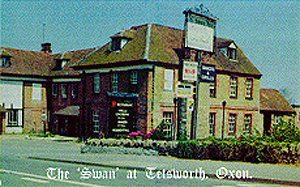 At the time, the Swan Inn was one of the main focal points for the
small village which was a stopover on the main route between London and Oxford.
The pub stayed in the hands of a Lindars for the next 60 years.
James obviously became quite wealthy as it was recorded in 1826 that he
owned the Swan Inn, had a London town house off Finsbury Square in addition to a farm and
shop in nearby Lewknor and several other pieces of land in and around Oxfordshire.
At the time, the Swan Inn was one of the main focal points for the
small village which was a stopover on the main route between London and Oxford.
The pub stayed in the hands of a Lindars for the next 60 years.
James obviously became quite wealthy as it was recorded in 1826 that he
owned the Swan Inn, had a London town house off Finsbury Square in addition to a farm and
shop in nearby Lewknor and several other pieces of land in and around Oxfordshire.
By 1852, the Swan Inn was partly converted into a post office.
Tetsworth was becoming a bustling village of about 550 inhabitants. It was
said that "before the railway, as many as 26 coaches used to pass through Tetsworth
each day." A school was built in 1847 by voluntary contribution,
holding about 90 children, each paying 2d per week..
Around the same time, independently or with the help of James, his two
brothers William and Richard
took over the Crown and Thistle Hotel in Abingdon (10 miles south of Oxford).
In 1861, William and Richard ran the Crown and Thistle, William’s son
Henry (my great-great grand father) was running the Queen’s Arms Hotel (between 1861-1863) also in
Abingdon. James’ son, William had
taken over the running of the Swan Inn. His wife was running the Post Office.
William’s brother Richard was the village
butcher, which stayed in the family until Richard’s son and grandson went to America
in around 1880s.
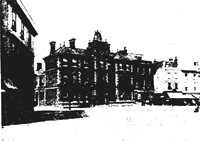
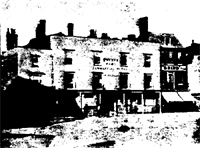 The Abingdon LINDARS left their pubs and moved to Reading between 1860
and 1882. The Queen’s Arms (see right; Before 1864 and After 1864) was demolished in the last 30 years.
The Crown and Thistle is still there and thriving, just off the market square
in Abingdon. The Swan Inn in Tetsworth was a successful pub until 15 years ago
when it was left derelict for some years. There was then a fire which
destroyed all of the carved and panelled woodwork of the beautiful, old building.
Today, ironically, it is an antique shop. The by-passing of the village
by the A40 and now the M40 has helped keep Tetsworth a quiet sleepy village, but has also
removed the one source of people and money that kept it alive.
The Abingdon LINDARS left their pubs and moved to Reading between 1860
and 1882. The Queen’s Arms (see right; Before 1864 and After 1864) was demolished in the last 30 years.
The Crown and Thistle is still there and thriving, just off the market square
in Abingdon. The Swan Inn in Tetsworth was a successful pub until 15 years ago
when it was left derelict for some years. There was then a fire which
destroyed all of the carved and panelled woodwork of the beautiful, old building.
Today, ironically, it is an antique shop. The by-passing of the village
by the A40 and now the M40 has helped keep Tetsworth a quiet sleepy village, but has also
removed the one source of people and money that kept it alive.
Modern Times
Since about 1850 the decendant LINDARS are either from the Abingdon or Tetsworth
side. Many of the Tetsworth LINDARS still live in and around Oxfordshire or in
neighbouring Bedfordshire. The Abingdon LINDARS seem to have been spread out
over different areas of the country. I would estimate that there are currently about 150
LINDARS in the UK today (including married ones), about 40 of these I have not been able
to place.
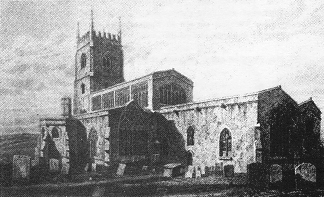 The origin that currently has the most weight is that the name LINDARS is of Swedish
descent, or certainly of Scandinavian origin. Several Swedish sources have
independently told me that LINDARS is a Swedish surname. As you will
see, we can trace at least one LYNDERS back to Oxfordshire in around 1590.
This would be a bit late to be Viking, but would more probably be
an immigrant from sometime during the 16th Century, who settled in Chipping Norton on the edge of the Cotswolds.
It would be nice to be able to find a record of this move, perhaps in all the ships’
logs which are held at the Public Record
Office in Kew.
The origin that currently has the most weight is that the name LINDARS is of Swedish
descent, or certainly of Scandinavian origin. Several Swedish sources have
independently told me that LINDARS is a Swedish surname. As you will
see, we can trace at least one LYNDERS back to Oxfordshire in around 1590.
This would be a bit late to be Viking, but would more probably be
an immigrant from sometime during the 16th Century, who settled in Chipping Norton on the edge of the Cotswolds.
It would be nice to be able to find a record of this move, perhaps in all the ships’
logs which are held at the Public Record
Office in Kew.










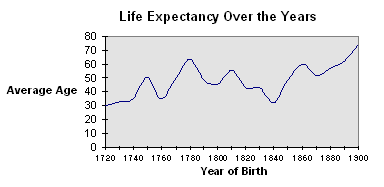 lived. A couple of the LINDARS
lived. A couple of the LINDARS  At the time, the Swan Inn was one of the main focal points for the
small village which was a stopover on the main route between London and Oxford.
The pub stayed in the hands of a Lindars for the next 60 years.
At the time, the Swan Inn was one of the main focal points for the
small village which was a stopover on the main route between London and Oxford.
The pub stayed in the hands of a Lindars for the next 60 years.

 The
The